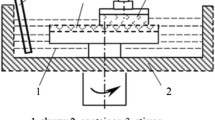Abstract
Mechanical polishing is the most common process to remove surface irregularities on fan blades such as scallop height features, while maintaining the required dimensional limits and textures. After the polishing process, the part will undergo shot peening, vibratory finishing, and later painting and coating at the final stages. It is therefore essential for the fan blade surface to be pre-treated with appropriate surface conditions to promote good surface-to-surface adhesion at the end of the manufacturing cycle. The existing method uses a single-axis rotary polishing tool where an external water coolant source is performed ad-hoc. This polishing method can produce average surface roughness, Ra, of 1.0 μm that satisfies the requirement. However, this form is aggressive and has a high material removal rate, resulting in excessive reduction in material thickness, and thus warrants rejection of costly fan blade. The main objective of this study is to better understand the influence of water and air coolant-induced surface texturing and its characterization by a proposed random-orbital polishing method. The criteria require surface roughness, Ra, between 0.8 and 1.0 μm and maximum height profile, Rz, between 5.0 and 6.0 μm for post-polishing condition, while maintaining low material removal rate to prevent under-thickness of the fan blade. Experimental trials are performed on fan blade specimens at the leading-edge sections and its surface topography characterized by coherence correlation interferometry. A range of different abrasive grit sizes is tested for suitability of media selection. Integrating in-line cooled air with deionized water to the process achieved desirable surface roughness, Ra, of 0.8 μm and height profile, Rz, of 5.8 μm, while simultaneously removing all traces of scallop height features and maintaining the leading-edge thickness within tolerance. Taking into consideration that the surface texture measurements are random in nature, the corresponding polishing methods were also analyzed with statistical functions by fast Fourier transform (FFT) and power spectral density (PSD). Comparison between the surface texture parameters or statistical functions with the corresponding polishing methods are then established. The surface integrity of the polished fan blade and wear condition of the abrasive disk are also reported in this study.















Similar content being viewed by others
Data availability
Nil.
References
Axinte DA, Kritmanorot M, Axinte M, Gindy NNZ (2005) Investigations on belt polishing of heat-resistant titanium alloys. J Mater Process Technol 166(3):398–404
Xiao GJ, Huang Y (2016) Equivalent self-adaptive belt grinding for the real-R edge of an aero-engine precision-forged blade. Int J Adv Manuf Technol 83(9–12):1697–1706
Wu D, Wang H, Zhang K, Lin X (2019) Research on flexible adaptive CNC polishing process and residual stress of blisk blade. Int J Adv Manuf Technol 103:2495–2513
Danyluk S, Ng SH (2013) Chemical mechanical polishing (CMP). In: Wang QJ, Chung YW (eds) Encyclopedia of Tribology. Springer, Boston, MA
Nasoohi N, Hoorizad M, Tabatabaei SF (2017) Effects of wet and dry finishing and polishing on surface roughness and microhardness of composite resins. J Dent (Tehran) 14(2):69–75
Wong H-C, Umehara N, Kato K (1998) The effect of surface roughness on friction of ceramics sliding in water. Wear 218(2):237–243 ISSN 0043-1648
Choi HZ, Lee SW, Jeong HD (2001) J Mater Process Technol 111:256
Nguyen T, Zhang L (2003) An assessment of the applicability of cold air and oil mist in surface grinding. J Mater Process Technol 140:224–230. https://doi.org/10.1016/S0924-0136(03)00714-3
Saberi A, Rahimi AR, Parsa H, Ashrafijou M, Rabiei F (2016) Improvement of surface grinding process performance of CK45 soft steel by minimum quantity lubrication (MQL) technique using compressed cold air jet from vortex tube. J Clean Prod 131
Cho S-S, Ryu Y-K, Lee S-Y (2002) Curved surface finishing with flexible abrasive tool. Int J Mach Tools Manuf 42(2):229–236 ISSN 0890-6955
Axinte DA, Kwong J, Kong MC (2009) Workpiece surface integrity of Ti-6-4 heat-resistant alloy when employing different polishing methods. J Mater Process Technol 209:1843–1852
Zhao T, Shi YY, Lin XJ, Duan JH, Sun PC, Zhang J (2014) Surface roughness prediction and parameters optimization in grinding and polishing process for IBR of aero-engine. Int J Adv Manuf Technol 74(653):663
Xue Y, Arjomandi M, Kelso R (2013) The working principle of a vortex tube. Int J Refrig 36:1730–1740. https://doi.org/10.1016/j.ijrefrig.2013.04.016
Zeng Q, Qin Y, Chang W, Luo X (2018) Correlating and evaluating the functionality-related properties with surface texture parameters and specific characteristics of machined components. Int J Mech Sci 149:62–72 ISSN 0020-7403
Nayak B, Babu NR (2020) A mechanistic approach to predict the material removal rate in Ice Bonded Abrasive Polishing (IBAP). Procedia Manuf 48:302–310 ISSN 2351-9789
Author information
Authors and Affiliations
Contributions
We would like to declare the contributions made by the following authors:
1) Edgar J Danaraj—Development of the experimental methodology, collection and compiling of data, and manuscript preparation
2) Swee Hock Yeo—Outline of the manuscript and review, analyses, and editing of the manuscript.
Corresponding author
Ethics declarations
Consent to participate
This is to confirm that all the authors have agreed to participate and have contributed in the content of the paper.
Conflict of interest
The authors declare no competing interests.
Additional information
Publisher’s note
Springer Nature remains neutral with regard to jurisdictional claims in published maps and institutional affiliations.
Rights and permissions
About this article
Cite this article
Danaraj, E.J., Yeo, S.H. Surface texturing of fan-blade body by random-orbital polishing with in-line aqueous mist. Int J Adv Manuf Technol 117, 3011–3027 (2021). https://doi.org/10.1007/s00170-021-07877-8
Received:
Accepted:
Published:
Issue Date:
DOI: https://doi.org/10.1007/s00170-021-07877-8




